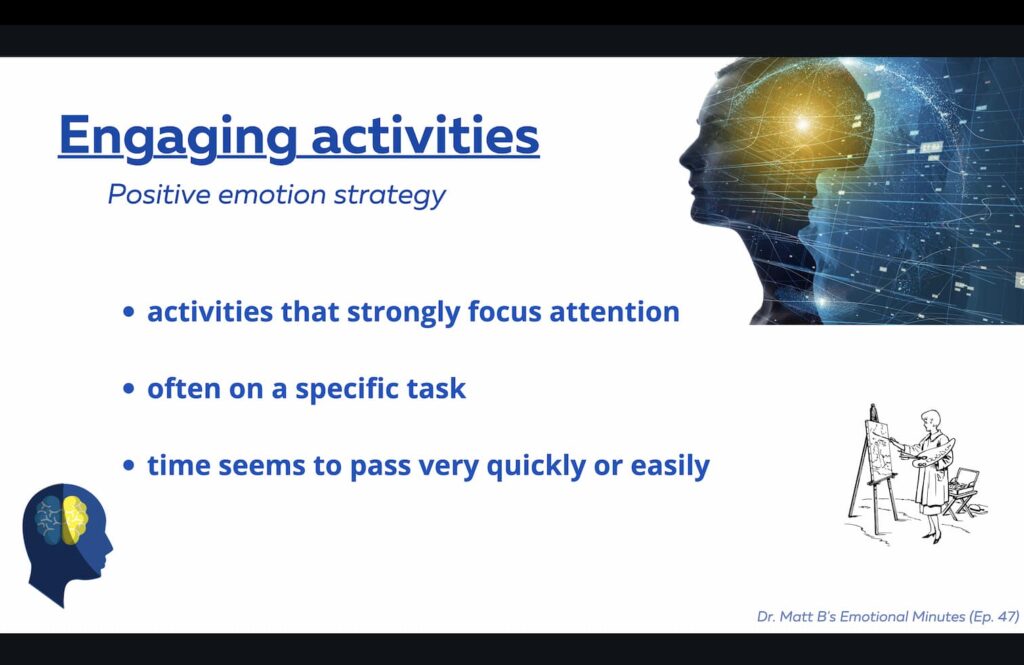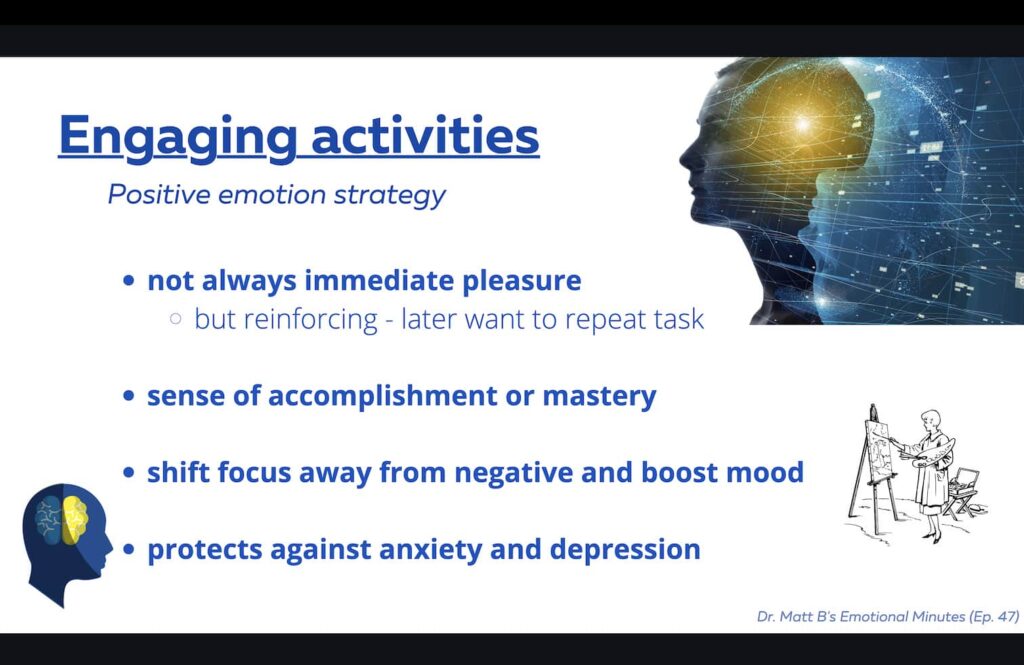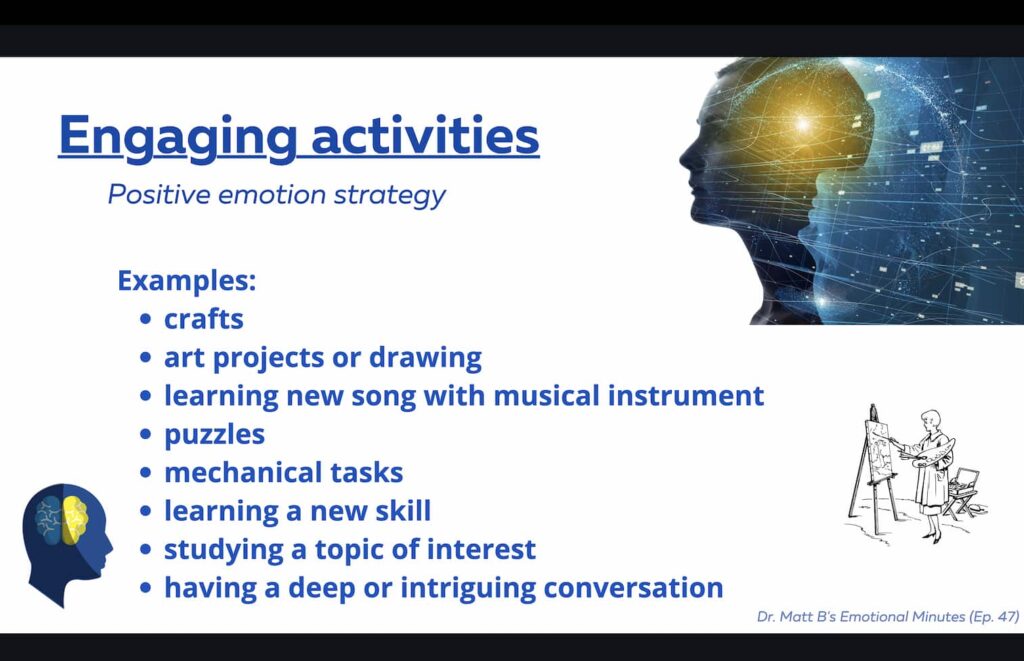Engaging activities are activities that capture our attention, keep us highly focused on and engaged in, and make it seem like time flies by. Engaging activities help get us into this “flow state”.
Engaging activities can also boost our mood and increase positive emotions. They also provide a sense of mastery and accomplishment, increase our confidence, and make us want to go back for more of those activities.
If you’re interested in more on engaging activities and flow state, this classic book outlines many ideas and research about flow and engagement.
Hi. I’m Dr. Matt B, and these are your Emotional Minutes. Welcome back. I am sitting here doing some music production and creation. This is something that I have gotten into a bit lately and want to learn more about. I found that this is a really engaging activity for me.
Engaging Activities and the Flow State
Activities that are engaging are one of the things that can boost positive emotions and boost your mood. Now, what do I mean when I say engaging activity? An engaging activity is something that captures your attention and that you stay focused on for a long period of time such that it feels like time just doesn’t go by. The “flow state” describes the feeling of being swept up in an activity.

Benefits of Engaging Activities and the Flow State
Engaging activities were found to show good benefits for your mood and emotions. Part of the reason for this is that staying focused on a task gives a sense of mastery and accomplishment when you finish. Sometimes people report not feeling a ton of pleasure when they’re doing the activity, but later on, they report that it was an enjoyable thing to do. This is something that is reinforcing. They want to go back and do that thing again.
What can happen with doing a lot of these engaging activities is that your mood can improve due to that sense of mastery or accomplishment that people often get when engaging in those tasks. Also, the powerful effect of focusing your attention away from negative situations that might be occurring and more toward the positive does help. This has the really beneficial effect of providing a protective factor or a buffer against things like anxiety and depression.

Examples of engaging tasks are learning a song on an instrument, playing a song, or improvising musically. It can also be things like doing crafts at home or an art project like drawing or painting. Even just doing puzzles or reading up on things that are really intriguing to you. One thing I like to read up on is history. The biggest point about this is not what the activity is, but if it’s something enjoyable and engaging. It should be something that captures your attention, and you get really into it and maybe experience the flow state.
Finding Engaging Activities
Now, sometimes people say “well, how do I know if something is engaging?” Typically, something is engaging if it’s mild to moderately challenging. Not challenging enough that it might produce anxiety or be something that you find so difficult that you just say “I don’t want to do this”. You also want something that’s not too easy or that you’re bored with.
Being in that kind of mild to moderate level of difficulty makes you more intrigued and almost creates sort of a mild challenge that you can stay engaged in. The challenge can provide that sense of mastery. Like what we talked about in the last episode on pleasurable or enjoying activities, this is something that is determined by you and what you find engaging. You can sit down and list the things that are engaging and slightly challenging for you.
Examples of Engaging Activities
Another thing about this, similar to what we talked about with pleasurable activities, is scheduling the activities. For example, I do this every Wednesday and Saturday. You can also bring them out when you need to, such as if you have had a more difficult day. It can help to say “I didn’t plan to do this today, but I’m going to break out an engaging activity that I know that I like.”
Another point that is similar to positive emotion strategies is activities that are social or non-social. This means it can be something you can do by yourself or socially. Activities you might do individually or socially are very beneficial. For example, a board game that’s really engaging for you, or a game of chess or checkers. If you play music, playing music with other people is a great engaging activity. It can also be doing an art project. Usually, a mix of those, socially and non-socially, can be pretty good. If you can add variety to this, that’s definitely very helpful as well.

Hopefully, that was helpful today in talking about engaging activities and their benefits. As well as ways to find activities that are engaging for you and ways to engage in and schedule them.
I’m Dr. Matt B, and I’m going to get back to some of this audio mixing. We will see you next time.



